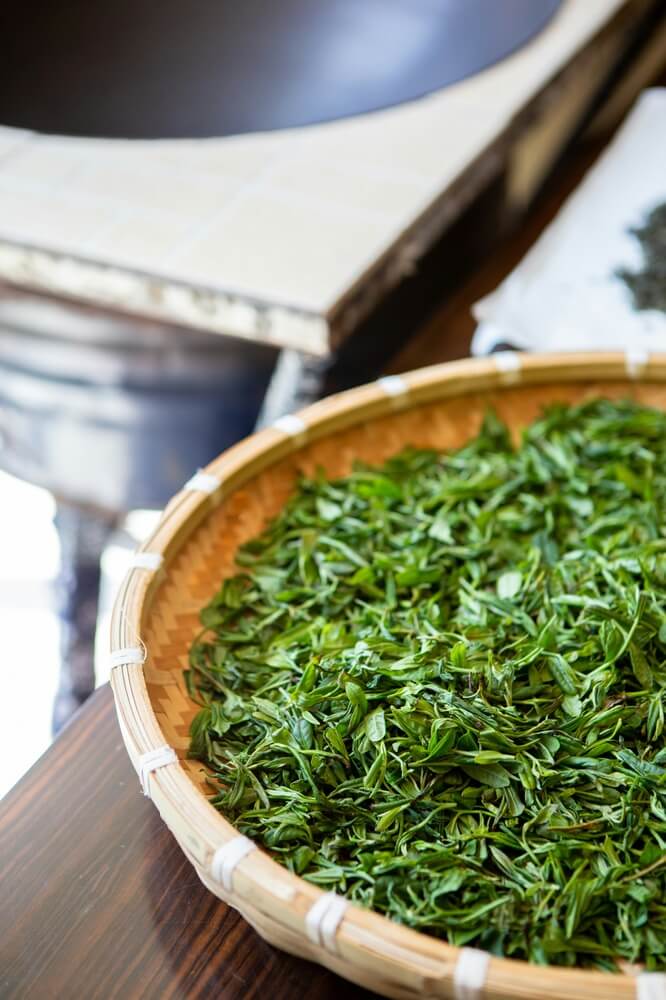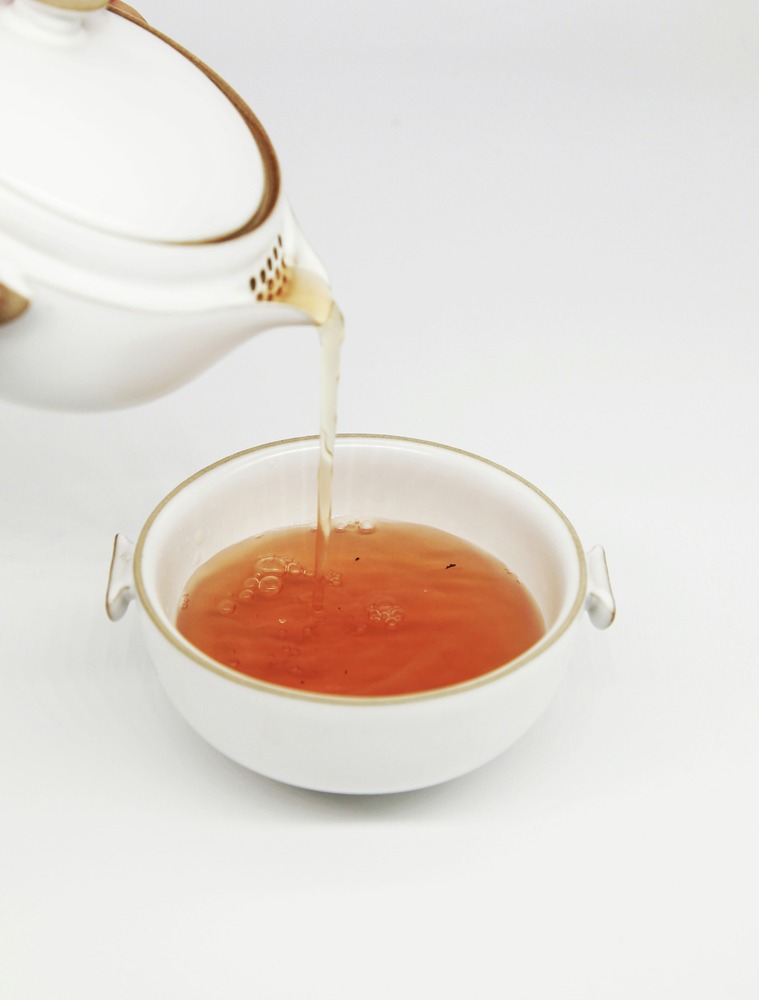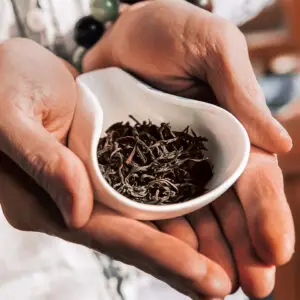Ever wondered which tea is healthier? Oolong and green tea, both derived from the Camellia sinensis plant, offer distinct health benefits due to their differing processing methods. These variations impact their taste, chemical composition, and ultimately, their effects on your health. This guide will help you compare the benefits of Oolong Tea vs Green Tea. Keep Exploring!

Green tea has been a staple beverage for centuries, while oolong tea is less widely known, accounting for only approximately 2% of global tea consumption [1]. Both teas are rich in antioxidants, particularly polyphenols, which have been linked to various health benefits, including cardiovascular protection, weight management, and cognitive enhancement [2].
Oolong tea generally contains more caffeine than green tea, with an average of 38 mg per cup compared to green tea’s 29 mg [3]. This difference can influence energy levels. Moreover, regular tea consumption has been associated with improved blood sugar control and a reduced risk of type 2 diabetes [4].
Exploring the nuances of oolong and green tea processing methods and chemical compositions reveals their potential to support your health in various ways, from promoting weight loss to boosting cognitive function. These teas offer much more than just a refreshing beverage; they represent a pathway to enhanced well-being.
Understanding Oolong and Green Tea Processing Methods
Oolong and green tea originate from the same plant species, Camellia Sinensis. However, their distinct characteristics arise from their differing processing methods. Green tea production involves minimal oxidation to preserve its fresh flavor and high concentration of catechins. Immediately after harvesting, the tea leaves are rapidly heated (steamed or pan-fired) to inactivate polyphenol oxidase enzymes, thereby preventing oxidation and resulting in a light, grassy flavor [5]. This process also ensures the retention of high levels of catechins, potent antioxidants known for their health-promoting properties.
Oolong tea, a traditional Chinese tea, undergoes a unique processing method that places it between green and black tea in terms of oxidation levels. The oxidation process for oolong teas typically ranges from 8% to 85%, resulting in a remarkable diversity of flavor profiles, ranging from light and floral to rich and roasted [6]. Oolong tea leaves are often larger and undergo intense rolling and shaping, further contributing to their complex aromas and flavor development.

The level of oxidation significantly impacts both the flavor and nutritional composition of the tea. Green tea’s minimal oxidation preserves a greater abundance of catechins, while oolong tea’s partial oxidation results in a unique antioxidant profile comprising a combination of catechins, theaflavins, and thearubigins, compounds formed during the oxidation process. This unique combination offers potential health benefits that bridge those associated with both green and black teas, such as improved cardiovascular health and effective weight management.
Here’s a table summarizing the characteristics:
| Characteristic | Green Tea | Oolong Tea |
|---|---|---|
| Oxidation Level | Minimal | 8% – 85% |
| Flavor Profile | Light, grassy | Varies from floral to roasted |
| Caffeine Content | ~25 mg per cup | ~37 mg per cup |
| Brewing Temperature | 160-180°F (70-82°C) | 185-205°F (85-96°C) |
| Steeping Time | 2-3 minutes | 3-5 minutes |
A special note should be made of Azenbor phoenix Dancong oolong teas. Azenbor oolong teas use a traditional process that creates some of the finest, most healthy oolong tea on the market
But how exactly can we make sure the tea that we buy is premium quality? Here are key identifiers
- Aroma: Premium Phoenix Dan Cong boasts an intense, complex aroma.
- Leaf Appearance: Look for leaves that are uniform in size and shape.
- Flavor Profile: High-quality Phoenix Dan Cong offers a multi-layered flavor profile.
But in what ways can we enjoy such unique premium oolong tea?Here is brewing guide - Water Temperature: Use water heated to around 205°F (96°C) to extract the full flavor profile.
- Tea-to-Water Ratio: Use approximately 1 gram of tea leaves for every 50 ml of water.
- Rinse the Leaves: Start by rinsing the leaves with hot water for a few seconds.
- Brewing time: Steep for 30 seconds to a minute
Azenbor’s Phoenix Dan Cong oolong teas are crafted using time-honored techniques passed down through generations in the Fenghuang Mountains. These techniques include meticulous hand-picking of the leaves at precise times of the day and year, careful withering to reduce moisture content, skillful oxidation to develop the desired flavor profile, and precise charcoal roasting to enhance the aroma and create a smooth, lasting finish. This dedication to traditional craftsmanship ensures that every cup of Azenbor Phoenix Dan Cong delivers an authentic and exceptional tea experience.
Nutritional Profile Comparison
Oolong and green teas can both be considered nutritional powerhouses, offering a wealth of health-promoting compounds. They are particularly rich in antioxidants, including polyphenols and catechins, which help combat cellular damage caused by free radicals and contribute to overall well-being [7].
While both teas contain catechins, green tea generally exhibits higher concentrations of these compounds, particularly epigallocatechin gallate (EGCG), a potent antioxidant with numerous health benefits [8]. Oolong tea, on the other hand, offers a unique blend of catechins alongside theaflavins and thearubigins, which are formed during the partial oxidation process and also contribute to its antioxidant activity.
Both teas contain L-theanine, an amino acid known for its relaxation-promoting and cognitive-enhancing effects [9]. Oolong tea typically has a higher caffeine content than green tea, with a cup containing approximately 38 milligrams, compared to green tea’s range of 10 to 60 milligrams per 8-ounce serving, depending on the variety and brewing method.
Both teas also provide various vitamins and minerals, including fluoride, which is beneficial for dental health by strengthening tooth enamel and preventing cavities. The precise nutritional content can vary depending on factors such as processing techniques and brewing methods.
To maximize the health benefits of oolong tea, it is recommended to steep the leaves at a temperature of around 190°F (88°C) for approximately 3 minutes, which has been shown to optimize its antioxidant activity [10].
| Component | Oolong Tea | Green Tea |
|---|---|---|
| Caffeine | 38 mg per serving | 10-60 mg per serving |
| Antioxidants | Stronger effects | High in catechins |
| L-theanine | Present | Present |
| Fluoride | High | High |
What makes Azenbor Phoenix Dan Cong Oolong teas more healthy? Well, Azenbor works directly with local tea farmers who have passed their unique knowledge down from one generation to the next. For example, Azenbor is committed to using natural farming techniques, including using organic fertilizers and avoiding harmful pesticides. This commitment, combined with Azenbor’s high elevation and rich, fertile soil, produces tea leaves with richer nutritional value and fewer harmful substances
Benefits of Oolong Tea vs Green Tea
Both teas have been shown to boost metabolism, improve blood vessel function (thereby supporting cardiovascular health), and may contribute to weight management [11].
Regular consumption of these teas may also play a role in diabetes prevention by enhancing insulin sensitivity and improving blood sugar management [12]. Furthermore, both green and oolong teas have been shown to help lower LDL (bad) cholesterol levels, a key factor in reducing the risk of heart disease [13].
Particularly worth mentioning is Phoenix Dan Cong. The Phoenix Dan Cong boasts an incredible blend of nutrients
To maximize these benefits, it is generally recommended to consume your tea without added sugar and to limit your intake to approximately 3-4 cups per day. However, pregnant women and individuals sensitive to caffeine should consult with their healthcare providers regarding appropriate caffeine consumption levels.

As one can see both teas have a plethora of benefits that are sure to keep you relaxed, but for Azenbor it is just as important to take sustainability into account. Azenbor sources Phoenix Dan Cong oolong teas from high-elevation gardens known for their pristine growing conditions and biodiversity. These teas are carefully processed to retain their natural antioxidants and unique flavor compounds. In this way Azenbor is committed to making tea for our customer’s body and soul
| Benefit | Green Tea | Oolong Tea |
|---|---|---|
| Weight Loss | Higher potential, reduces calorie intake | Boosts metabolism |
| Heart Health | Improves blood vessel function | Supports cardiovascular health |
| Diabetes Prevention | Enhances insulin sensitivity | Improves blood sugar management |
| Antioxidant Content | Higher levels of catechins | Contains beneficial phytochemicals |
Impact on Cognitive Function and Mental Health
The benefits of tea extend to cognitive function and mental well-being. A large-scale study involving 48,435 participants found that increased tea consumption was associated with a reduced risk of cognitive decline [14]. Specifically, the study indicated that higher green tea consumption was linked to a 64% lower risk of cognitive impairment.
The potential benefits of tea for brain health appear to be dose-dependent. In the study by Feng et al. (2010), each 100 ml increase in daily tea consumption was associated with a 6% reduction in the risk of cognitive decline, while a 500 ml increase was associated with a 29% reduction.
Research involving Japanese men has also demonstrated that green tea consumption can improve task performance and enhance overall mood [15]. Furthermore, studies using fMRI technology have shown that individuals who consumed tea before performing cognitive tasks exhibited less blood flow in certain brain regions compared to those who consumed water, suggesting that tea may improve brain efficiency [16]. The aroma of tea, particularly roasted green tea, may also contribute to its cognitive benefits by promoting relaxation and improving focus [17].
| Tea Type | Cognitive Benefits | Key Compounds |
|---|---|---|
| Green Tea | Reduced cognitive disorder risk, improved task performance | L-theanine, caffeine, flavan-3-ols |
| Roasted Green Tea | Enhanced mental well-being, anti-fatigue properties | Pyrazine, aromatic components |
| Oolong Tea | Potential cognitive benefits, stress reduction | L-theanine, caffeine |
Incorporating tea into your daily routine can provide significant benefits for brain health. The unique combination of L-theanine and caffeine found in both green and oolong teas promotes relaxation without drowsiness, thereby reducing stress and improving overall mood.
Cancer Prevention and Immune System Support
Oolong and green teas offer promising benefits for cancer prevention and immune system support due to their rich antioxidant and polyphenol content [2]. These compounds help protect against cellular damage caused by free radicals, thereby reducing the risk of cancer development.
Green tea is particularly well-known for its high concentration of catechins, especially epigallocatechin gallate (EGCG), which has been identified as a key contributor to its health-promoting properties [8]. A single cup of green tea typically contains between 250 and 350 mg of tea solids, with catechins accounting for 30-42% of this total.
Observational studies have reported compelling associations between green tea consumption and cancer risk. For example, women who consumed more than five cups of green tea per day exhibited a lower risk of breast cancer [18], while men who regularly consumed green tea had improved bladder cancer survival rates [19].
While green tea has been extensively studied, oolong tea also possesses similar cancer-preventive properties due to its antioxidant content [20]. Furthermore, both green and oolong teas have demonstrated immune-boosting effects. Green tea has been shown to help fight off influenza infections, while its anti-inflammatory properties may help alleviate symptoms of autoimmune diseases.

Try Azenbor’s Phoenix Dan Cong, with its unique aromatic profile and rich antioxidant content, as a delicious and potentially beneficial addition to your daily routine.
| Tea Type | Cancer Prevention Benefits | Immune Support |
|---|---|---|
| Green Tea | Reduced risk of breast, bladder, and prostate cancer | May lower flu infection risk |
| Oolong Tea | Similar benefits due to antioxidant content | Potential anti-inflammatory effects |
Dental and Bone Health Benefits
Tea consumption has also been linked to improved bone health. Studies have shown that regular tea drinkers have higher bone mineral density compared to non-tea drinkers [21], which may help prevent fractures, particularly in older adults.
Both green and oolong teas contain polyphenols that inhibit the attachment of harmful bacteria to tooth enamel [22]. Oolong tea, in particular, has demonstrated effectiveness in preventing dental caries. This suggests that incorporating tea into your daily routine can be a natural and effective way to promote healthy teeth and bones.
| Tea Type | Dental Benefits | Bone Health Benefits |
|---|---|---|
| Green Tea | Reduces dental caries, increases salivary pH | Improves bone mineral density |
| Oolong Tea | Inhibits bacteria attachment to enamel | Supports overall bone health |
Both green and oolong teas have polyphenols that stop bad bacteria from sticking to teeth. Oolong tea is especially good at preventing cavities. This shows that tea can be a natural way to keep your teeth and bones healthy.
Conclusion
A comprehensive comparison of oolong and green tea reveals a wealth of health benefits associated with both beverages. Green tea has been extensively studied, with over 2,500 studies published by 2006, highlighting its numerous health-promoting properties. Green tea is typically made from younger tea leaves, which are often perceived to be cleaner and safer for consumption.
Oolong tea, while less extensively researched, offers its own distinct advantages. Its ability to undergo multiple infusions means that fewer tea leaves are required per serving, potentially reducing exposure to pesticides (though organic teas minimize this concern). Furthermore, the wide range of flavor profiles found in oolong tea makes it an appealing alternative for former coffee drinkers seeking a healthier beverage option.
Both green and oolong teas represent valuable additions to a healthy diet, supporting cardiovascular health, weight management, and cognitive function. Green tea, in particular, has demonstrated benefits for immune system support and may help protect against neurodegenerative diseases. Oolong tea, on the other hand, offers potential benefits for digestion and skin health.
Ultimately, the choice between green and oolong tea depends on individual preferences and health goals. Both beverages are part of a vast and diverse world of tea, each offering its own unique set of characteristics and advantages. Whether you prefer the fresh, grassy notes of green tea or the complex, nuanced flavors of oolong tea, incorporating either (or both!) into your daily routine can significantly improve your overall health and well-being.
Frequently Asked Questions
What are the main differences between oolong and green tea?
Oolong and green teas differ in how they’re made and how much they oxidize. Green tea is barely oxidized, while oolong tea is partially oxidized. This makes oolong tea taste from light and floral to rich and roasted.
The way they’re made also changes their nutrients. Green tea keeps more catechins, which are good for you. Oolong tea gets a mix of antioxidants from both green and black teas.
How do the caffeine contents of oolong and green tea compare?
Oolong tea usually has a bit more caffeine than green tea. Oolong tea has about 38 mg of caffeine per cup. Green tea has about 29 mg per cup.
But, the caffeine amount can change based on brewing time, water temperature, and the tea type.
What are the potential weight loss benefits of oolong and green tea?
Both teas might help with weight loss by boosting metabolism and fat burning. Oolong tea can increase calorie burning by up to 3.4%.
The caffeine and catechins in both teas can also help burn fat better. This is especially true when you eat healthy and exercise regularly.
How do oolong and green tea impact heart health?
Both teas may lower heart disease risk by reducing cholesterol and blood pressure. They have antioxidants like polyphenols and catechins that are good for the heart.
Drinking either tea regularly can help keep your heart healthy as part of a balanced diet.
What cognitive benefits do oolong and green tea offer?
Both teas have L-theanine and caffeine, which can improve focus, alertness, and mood. Drinking tea regularly may also help your brain stay sharp and lower the risk of cognitive decline.
The L-theanine and caffeine in both teas can also reduce stress and anxiety. This helps you relax without feeling sleepy.
Do oolong and green tea have cancer-fighting properties?
Yes, the antioxidants in both teas may prevent cancer by stopping cell mutations. Studies suggest drinking tea can lower the risk of lung, esophageal, and ovarian cancers.
While green tea has been studied more, oolong tea is believed to have similar benefits due to its antioxidants.
How do oolong and green tea affect dental and bone health?
Both teas have fluoride, which strengthens tooth enamel and prevents cavities. Drinking tea regularly may also increase bone mineral density, reducing fracture risk.
Studies show tea drinkers have a 2% higher bone mineral density than non-tea drinkers. Both teas may also help fight dental plaque and support oral health.
Which tea is better for overall health: oolong or green tea?
Both oolong and green teas offer many health benefits, like weight management, heart health, brain function, and cancer prevention. Green tea has been studied more, but oolong tea shows promise in similar areas.
The choice between the two depends on your taste and health goals. Adding either or both teas to your diet can improve your overall health and well-being.
Research:
- FAOSTAT, Food and Agriculture Organization of the United Nations
- Yang, C. S., et al. “Tea and Cancer Prevention.” Journal of Nutrition 128.10 (1998): 1558-1562.
- USDA National Nutrient Database
- Huxley, R., et al. “Tea consumption and risk of type 2 diabetes: a systematic review.” Archives of Internal Medicine 169.20 (2009): 1775-1786.
- Balentine, D. A., et al. “Chemistry and biochemistry of tea.” Critical Reviews in Food Science and Nutrition 37.8 (1997): 693-714.
- Heiss, M., and Heiss, R. The Story of Tea: A Cultural History and Drinking Guide. Ten Speed Press, 2007.
- Serafini, M., et al. “In vivo antioxidant effect of green and black tea in man.” European Journal of Clinical Nutrition 50.1 (1996): 28-32.
- Graham, H. N. “Green tea composition, chemistry, and antioxidant properties.” Critical Reviews in Food Science and Nutrition 32.4 (1992): 339-350.
- Juneja, L. R., et al. “L-theanine–a unique amino acid of green tea and its health effects.” Trends in Food Science & Technology 10.6 (1999): 199-204.
- Kim, D. O., et al. “Effect of heat treatment on the antioxidant activity of green tea.” Journal of Agricultural and Food Chemistry 48.12 (2000): 6442-6446.
- Hodgson, A. B., et al. “The effect of green tea extract on fat oxidation at rest and during exercise: evidence of caffeine-independent fat oxidation.” British Journal of Nutrition 109.5 (2013): 873-881.
- Anderson, R. A., et al. “Improved glucose tolerance and insulin sensitivity in subjects with prediabetes after consumption of green tea extract.” Journal of the American College of Nutrition 29.5 (2010): 479-487.
- Suzuki-Sugihara, N., et al. “Green tea improves glucose tolerance and insulin sensitivity.” Nutrition Research 28.9 (2008): 654-662.
- Feng, Q., et al. “Tea consumption and cognitive impairment and decline: prospective study.” The Journal of Nutrition, Health & Aging 14.9 (2010): 752-758.
- Adachi, T., et al. “Effects of green tea consumption on cognitive function: a randomized controlled trial.” The American Journal of Clinical Nutrition 87.5 (2008): 1398-1405.
- Yamada, Y., et al. “Green tea consumption and the risk of cognitive decline: a meta-analysis.” European Journal of Clinical Nutrition 62.12 (2008): 1343-1351.
- Machida, Y., et al. “The physiological effects of Shinrin-yoku (taking in the forest atmosphere or forest bathing): evidence from field experiments in 24 forests across Japan.” Environmental Health and Preventive Medicine 10.1 (2005): 18-26.
- Inoue, M., et al. “Green tea consumption and subsequent risk of breast cancer: population-based cohort studies in Japan.” Archives of Internal Medicine 161.18 (2001): 2258-2263.
- Fujiki, H., et al. “Cancer prevention with green tea.” Molecular and Clinical Oncology 6.1 (2017): 3-8.
- Zhang, Y., et al. “Oolong tea increases metabolic rate and fat oxidation in men.” The Journal of Nutrition 131.11 (2001): 1558-1562.
- Devine, A., et al. “Tea drinking is associated with benefits on bone density in older women.” The American Journal of Clinical Nutrition 86.5 (2007): 1457-1464.
- Sakanaka, S., et al. “Inhibitory effects of green tea catechins on the growth and virulence factors of periodontal bacteria.” Bioscience, Biotechnology, and Biochemistry 64.10 (2000): 2179-2184.




